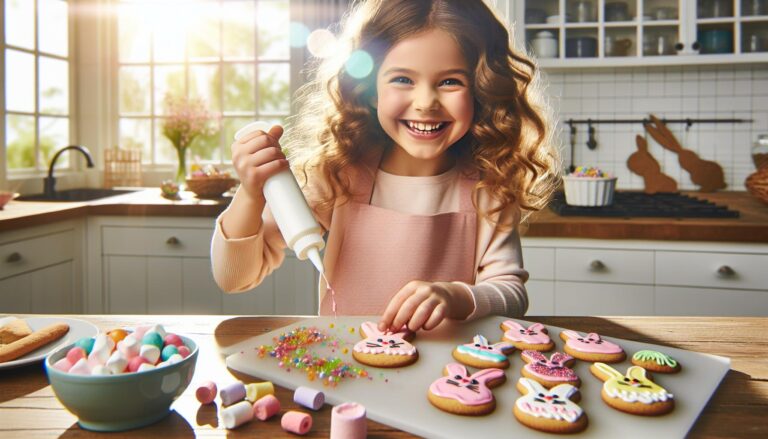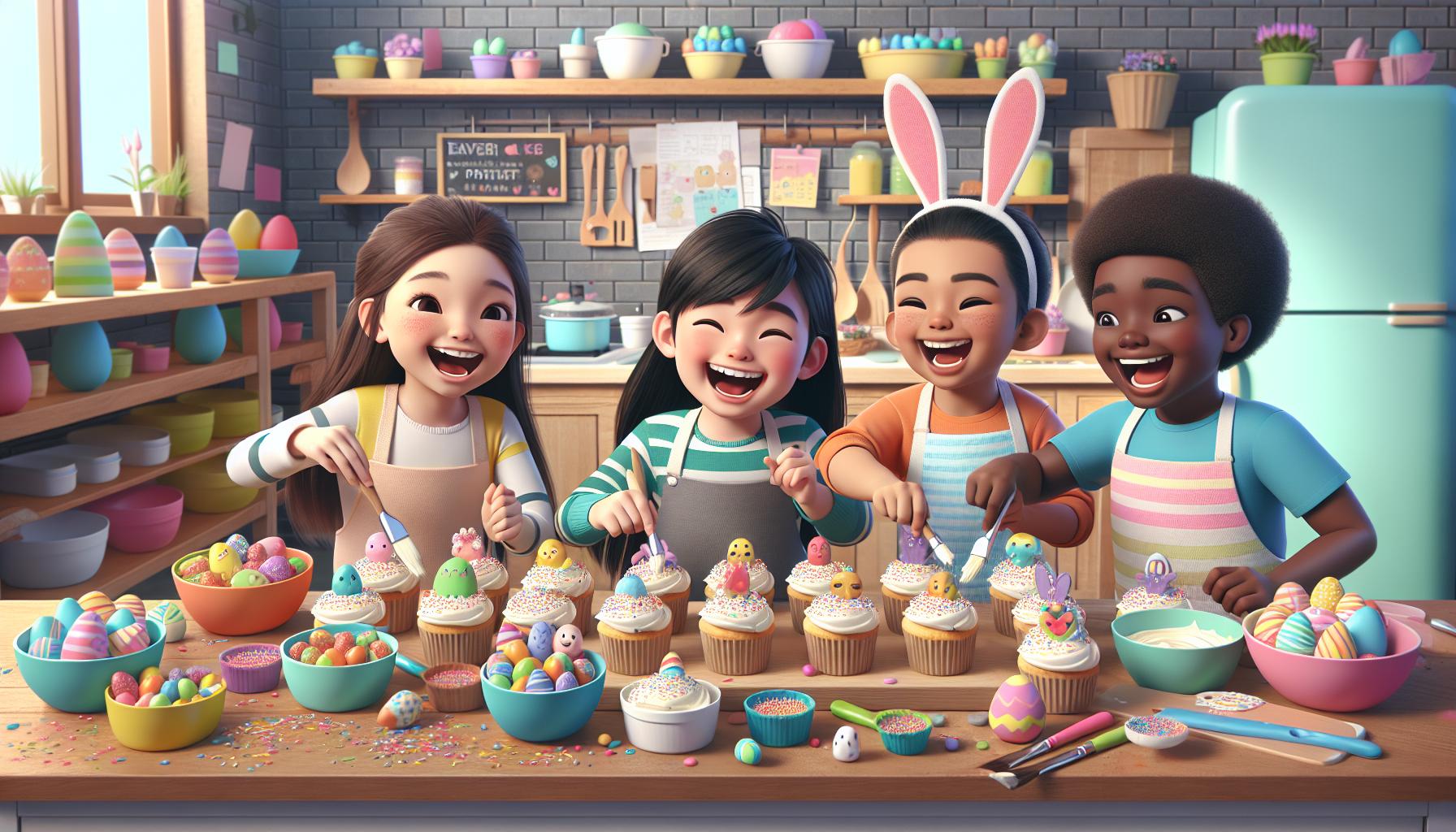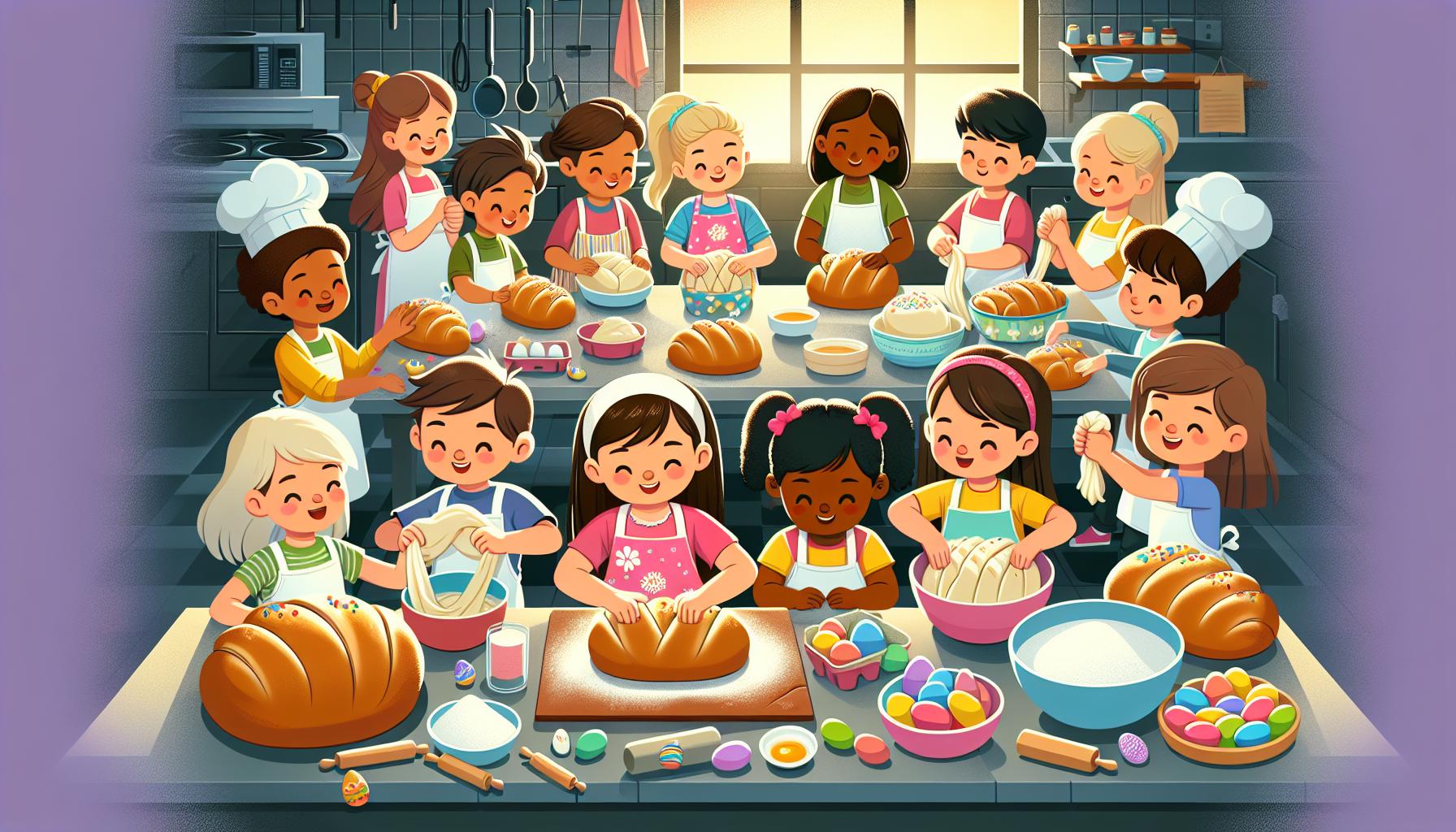
Easter brings the perfect opportunity to create sweet memories with kids in the kitchen. We’ve discovered that baking isn’t just about making delicious treats – it’s a fantastic way for children to learn essential skills while having fun. From measuring ingredients to following recipes kids can develop their math abilities coordination and confidence all at once.
Looking for ways to keep your little ones entertained this Easter season? Baking activities offer the ideal blend of education and entertainment. Whether you’re working with classic cookie recipes or trying out festive cupcake designs there’s something magical about watching children light up as they master new baking techniques. Plus these hands-on activities help kids understand kitchen science basics while creating treats they’ll be proud to share with family and friends.
Key Takeaways
- Easter baking provides an educational opportunity for kids to develop math skills, coordination, and kitchen confidence while creating delicious treats
- Kid-friendly Easter baking projects include decorated bunny and egg sugar cookies, festive cupcakes, braided Easter bread, and simple no-bake treats like chocolate-dipped pretzels
- Basic safety rules are essential – including proper hand washing, using age-appropriate tools, adult supervision for hot items, and maintaining a clean workspace
- Essential baking tools for kids include child-sized aprons, non-slip mixing bowls, plastic measuring tools, and Easter-themed cookie cutters with rounded edges
- Age-appropriate tasks should be assigned – younger children (2-3) can pour and stir, while older kids (6+) can handle more complex tasks like using electric mixers and following recipes
Fun and Easy Easter Cookie Decorating
Easter cookie decorating offers kids a creative outlet to express their artistic side while making delicious treats. Here’s how to create two classic Easter cookie designs that children love to make.
Bunny-Shaped Sugar Cookies
Creating bunny-shaped sugar cookies starts with rolling out chilled dough to 1/4-inch thickness. Let kids use bunny-shaped cookie cutters to cut out shapes. Here’s what makes these cookies extra special:
- Add mini marshmallows for fluffy tails
- Create whiskers using thin licorice strips
- Pipe pink frosting noses with a small round tip
- Sprinkle coconut flakes for fuzzy texture
- Use candy eyes or small chocolate chips for eyes
Easter Egg Sugar Cookies
Easter egg cookies transform basic sugar cookies into colorful masterpieces. These oval-shaped treats provide the perfect canvas for kids’ creativity:
- Spread white royal icing as a base
- Divide frosting into small bowls for multiple colors
- Use squeeze bottles for easy application
- Create patterns with:
- Pastel sprinkles
- Colored sugar
- Edible glitter
- Small candies
- Piped zigzags
- Let kids mix colors to make marbled effects
- Add edible paint details using food coloring mixed with clear vanilla extract
| Tool | Purpose |
|---|---|
| Squeeze Bottles | Controlled icing application |
| Small Paint Brushes | Detail work |
| Offset Spatula | Smooth frosting |
| Piping Bags | Design creation |
| Cookie Cutters | Shape formation |
Festive Easter Cupcakes

Easter cupcakes transform simple treats into eye-catching desserts perfect for children to decorate. These mini masterpieces let kids express their creativity while practicing basic baking skills.
Carrot Patch Cupcakes
Carrot patch cupcakes bring garden-fresh charm to any Easter celebration. Start with chocolate cupcakes as the base “dirt” topped with chocolate frosting. Add crushed chocolate cookies for soil texture then insert orange candy carrots made from fondant or modeling chocolate. Kids love placing green sprinkle “stems” on top of each carrot. Create 3-4 carrots per cupcake in varying sizes for a realistic garden effect.
Chick and Bunny Themed Designs
Transform vanilla cupcakes into adorable Easter characters using simple decorating techniques. Create fluffy chicks with yellow buttercream frosting piped in swirls, orange fondant beaks small triangle shapes, and mini chocolate chips for eyes. For bunny cupcakes, use white frosting to pipe tall ear shapes, pink fondant for inner ears, and black icing dots for facial features. Let kids mix and match designs adding jelly beans, coconut “grass,” or pastel sprinkles to customize their creations.
- Piping bags with round and star tips
- Fondant in yellow, white, pink, orange
- Candy decorations like mini chocolate chips jelly beans
- Food coloring in spring pastels
- Small offset spatulas for spreading frosting
Easter Bread Making for Kids

Easter bread making introduces children to traditional holiday baking while teaching them valuable kitchen skills. Our kid-friendly recipes create lasting memories through hands-on activities.
Sweet Braided Easter Bread
Making braided Easter bread lets kids practice their dough-handling skills through simple twisting motions. Here’s a basic recipe that creates a soft dough perfect for small hands:
- Mix 3 cups all-purpose flour, 1/4 cup sugar, 1 packet active yeast
- Add 2 beaten eggs, 1/2 cup warm milk, 4 tablespoons butter
- Knead until smooth (kids love this part!)
- Divide into 3 ropes
- Braid the ropes together
- Decorate with colored eggs
Kid-Friendly Tips:
- Let kids measure dry ingredients
- Show them how to test yeast activity
- Demonstrate braiding techniques with play dough first
- Paint the bread with egg wash using child-safe brushes
Hot Cross Buns
Hot cross buns offer kids multiple decorating opportunities while learning about yeast dough. This simplified version keeps children engaged throughout the process:
- Combine dry ingredients in a large bowl
- Add raisins or dried fruit
- Mix wet ingredients separately
- Form small round buns
- Create crosses with flour paste
- Brush with glaze after baking
- Count raisins for each bun
- Practice rolling dough into balls
- Draw crosses on paper first
- Use plastic piping bags for crosses
| Step | Time | Kid’s Task |
|---|---|---|
| Mixing | 10 min | Measuring ingredients |
| Rising | 60 min | Checking dough size |
| Shaping | 15 min | Rolling dough balls |
| Decorating | 10 min | Making crosses |
| Baking | 20 min | Timer watching |
No-Bake Easter Treats
Creating Easter treats doesn’t always require an oven. These simple no-bake recipes let kids participate in holiday baking while developing their kitchen skills in a safe environment.
Easter Nest Rice Krispie Treats
Rice Krispie treats transform into festive Easter nests with a few creative additions. Mix cereal with melted marshmallows then shape the mixture into small nests using greased muffin tins. Kids can decorate their nests with shredded coconut tinted green with food coloring for grass effects. Top each nest with chocolate eggs, jelly beans or candy-coated chocolates for a playful finishing touch.
Key decorating items:
- Green-tinted coconut
- Mini chocolate eggs
- Pastel jelly beans
- Candy-coated chocolates
- Candy sprinkles
Chocolate-Dipped Easter Pretzels
Dipping pretzels in chocolate creates a sweet-salty treat that’s perfect for small hands to craft. Melt white chocolate or colored candy melts in separate bowls. Kids can dip pretzel rods or twists then add Easter-themed sprinkles before the chocolate sets.
Decoration options:
- Pastel candy melts
- Easter-themed sprinkles
- Crushed candy pieces
- Colored sugar
- Mini marshmallows
Tips for success:
- Line work surfaces with wax paper for easy cleanup
- Use shallow bowls for better dipping control
- Place decorated pretzels in the refrigerator for 10 minutes to set
- Store in airtight containers between wax paper layers
- Keep at room temperature for up to 5 days
| Item | Amount per 12 pretzels |
|---|---|
| Candy melts | 8 ounces |
| Sprinkles | 1/4 cup |
| Crushed candy | 1/3 cup |
| Colored sugar | 2 tablespoons |
Kitchen Safety Tips for Baking With Kids
Basic Safety Rules
- Keep hands clean by washing with soap for 20 seconds before touching ingredients
- Tie back long hair securely with hair bands or clips
- Roll up loose sleeves to prevent fabric from touching food
- Remove jewelry including rings bracelets necklaces
- Wear a clean apron to protect clothes from spills
Kitchen Equipment Safety
- Place sharp tools like knives scissors away from counter edges
- Use plastic bowls instead of glass when mixing ingredients
- Turn pot handles inward on stovetop to prevent accidental spills
- Keep electric mixers unplugged when not in use
- Store oven mitts within easy reach near the oven
Safe Handling of Hot Items
- Adults handle hot pans trays ovens exclusively
- Set up a designated cooling area away from edges
- Use trivets heat-resistant mats under hot items
- Keep ice packs first aid supplies readily available
- Maintain a 3-foot kid-free zone around hot appliances
Ingredient Safety
- Check expiration dates on all ingredients
- Store raw eggs separately from other ingredients
- Avoid tasting raw dough containing eggs
- Keep ingredients in original containers with labels visible
- Use separate cutting boards for different ingredients
Age-Appropriate Tasks
Ages 2-3
- Pour pre-measured ingredients
- Stir room temperature batters
- Sprinkle decorations
Ages 4-5
- Crack eggs into separate bowls
- Measure dry ingredients
- Roll dough into balls
Ages 6-7
- Mix ingredients with electric mixer
- Frost cooled baked goods
- Shape dough into simple forms
- Read measure follow simple recipes
- Use cookie cutters decorating tools
- Help with timer temperature settings
| Age Group | Safe Tools | Supervised Activities |
|---|---|---|
| 2-3 years | Plastic bowls spoons | Mixing stirring decorating |
| 4-5 years | Measuring cups spoons | Pouring measuring ingredients |
| 6-7 years | Rolling pins cutters | Dough shaping decorating |
| 8+ years | Electric mixer timer | Recipe reading measuring |
Essential Easter Baking Tools and Supplies
The right baking tools transform Easter treats from basic to spectacular. Here’s a comprehensive list of essential supplies for successful Easter baking with kids:
Basic Baking Equipment
- 2-3 mixing bowls in different sizes
- 1 set of measuring cups and spoons
- Electric hand mixer or stand mixer
- 2 baking sheets with parchment paper
- Cooling racks
- Silicone spatulas
- Easter-themed cookie cutters (bunnies, eggs, chicks)
Decorating Tools
- Piping bags (3-4 reusable or disposable)
- Basic piping tips set
- Offset spatula for frosting
- Food coloring in spring colors
- Decorating brushes
- Small containers for sprinkles
- Rolling pin
- Cookie stencils
Kid-Friendly Safety Items
- Child-sized aprons
- Oven mitts for small hands
- Non-slip mixing bowls
- Plastic measuring tools
- Step stool for counter access
- Plastic cutting boards
- Clean kitchen towels
- Airtight containers
- Decorative treat bags
- Easter-themed gift boxes
- Storage labels
- Twist ties or ribbons
- Paper cupcake boxes
- Clear cellophane wrap
Each tool serves a specific purpose in creating Easter treats. Pre-measured ingredients in individual containers help kids stay organized. Clear plastic bowls let children see ingredient transformations as they mix. Color-coded measuring tools make following recipes easier for young bakers.
| Essential Tool | Primary Use | Kid-Friendly Features |
|---|---|---|
| Mixing Bowls | Combining ingredients | Non-slip base, lightweight |
| Measuring Set | Precise portions | Color-coded, plastic construction |
| Cookie Cutters | Shaping dough | Rounded edges, easy-grip handles |
| Piping Bags | Decorating treats | Reusable, easy-clean material |
These tools support independent baking while maintaining safety. How do you plan to organize your baking supplies for Easter projects with kids?
Conclusion
Easter baking with kids is more than just creating delicious treats – it’s about building memories and skills that’ll last a lifetime. We’ve shared numerous kid-friendly recipes and decorating ideas that combine fun with learning opportunities in the kitchen.
Whether you choose to tackle our traditional Easter bread recipes or stick to no-bake treats there’s something here for every skill level. By following our safety guidelines and using the right tools we can make Easter baking a cherished family tradition that kids will look forward to year after year.
So let’s gather our supplies put on those aprons and start creating magical Easter memories in the kitchen with our little ones!
Frequently Asked Questions
What are the benefits of baking with children during Easter?
Baking with children during Easter offers multiple benefits including the development of math skills through measuring, improved hand-eye coordination, increased confidence, and understanding of basic kitchen science. It’s also a fun way to create lasting memories while making delicious treats that can be shared with family and friends.
What age is appropriate for children to start baking?
Children can start participating in baking activities as early as 2-3 years old with proper supervision. Toddlers can help with simple tasks like pouring pre-measured ingredients and mixing, while older children (5+) can take on more complex tasks like measuring and decorating.
What are some easy Easter treats kids can make?
No-bake Easter treats are perfect for beginners, such as Easter Nest Rice Krispie Treats and Chocolate-Dipped Easter Pretzels. Kids can also make simple decorated sugar cookies, festive cupcakes with Easter themes, and traditional Easter bread with supervision.
What safety precautions should be taken when baking with kids?
Essential safety measures include hand washing, wearing clean aprons, tying back long hair, using age-appropriate tools, and constant adult supervision. Keep children away from hot surfaces and sharp objects, and teach them proper kitchen safety rules before starting.
What basic tools are needed for Easter baking with kids?
Key tools include measuring cups and spoons, mixing bowls, baking sheets, cookie cutters, decorating supplies (piping bags, sprinkles), and child-sized aprons. Non-slip mixing bowls and safety equipment are also important for a secure baking environment.
How can I make Easter baking educational for children?
Incorporate learning by teaching math through measuring ingredients, science through discussing how ingredients react together, creativity through decorating, and following instructions through recipes. Use the experience to develop patience and problem-solving skills.

